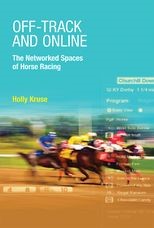Off-Track and Online: The Networked Spaces of Horse Racing
Off-Track and Online: The Networked Spaces of Horse Racing
Cite
Abstract
Horse racing has played a significant role in the development and use of new media technologies and media spaces. With the beginning of modern horse racing in the nineteenth century, racetracks became leisure destinations, with physical spaces that structured and were structured by social and cultural practices. By the late 1800s, in the days before theme parks, tracks served as vacation sites. The invention of an early computer, the totalizator, at the turn of the twentieth century allowed horse racing to help usher in the information age. The totalizator made pari-mutuel wagering, in which race odds are determined by the bets of participants in a gambling market, manageable. It also enabled near-instantaneous data processing of bets and posting of odds, and it facilitated networks that linked live racing with remote sites: from telegraph-connected “pool rooms” to late twentieth-century off-track betting facilities (OTBs). OTBs pioneered the use of non-ambient public screens, and the arrangement of social space around public screens. Interactive television and the Internet have moved participation in online pari-mutuel markets from public to private space, highlighting and challenging the traditional divide between public and domestic sphere. In addition, fans of racehorses use social media to share the products of their uncompensated and femininely-gendered labor, from fan videos to real-time information needed to rescue former racehorses. Indeed, throughout its modern history, the practices of horse racing have underscored the roles played by gender, race, and class in technology use.
Sign in
Personal account
- Sign in with email/username & password
- Get email alerts
- Save searches
- Purchase content
- Activate your purchase/trial code
Institutional access
-
Sign in through your institution
- Sign in with a library card Sign in with username/password Recommend to your librarian
Institutional account management
Sign in as administratorPurchase
Our books are available by subscription or purchase to libraries and institutions.
Purchasing information| Month: | Total Views: |
|---|---|
| January 2023 | 2 |
| March 2024 | 1 |
| March 2024 | 1 |
| March 2024 | 1 |
| March 2024 | 1 |
| April 2024 | 1 |
| April 2024 | 1 |



Get help with access
Institutional access
Access to content on Oxford Academic is often provided through institutional subscriptions and purchases. If you are a member of an institution with an active account, you may be able to access content in one of the following ways:
IP based access
Typically, access is provided across an institutional network to a range of IP addresses. This authentication occurs automatically, and it is not possible to sign out of an IP authenticated account.
Sign in through your institution
Choose this option to get remote access when outside your institution. Shibboleth/Open Athens technology is used to provide single sign-on between your institution’s website and Oxford Academic.
If your institution is not listed or you cannot sign in to your institution’s website, please contact your librarian or administrator.
Sign in with a library card
Enter your library card number to sign in. If you cannot sign in, please contact your librarian.
Society Members
Society member access to a journal is achieved in one of the following ways:
Sign in through society site
Many societies offer single sign-on between the society website and Oxford Academic. If you see ‘Sign in through society site’ in the sign in pane within a journal:
If you do not have a society account or have forgotten your username or password, please contact your society.
Sign in using a personal account
Some societies use Oxford Academic personal accounts to provide access to their members. See below.
Personal account
A personal account can be used to get email alerts, save searches, purchase content, and activate subscriptions.
Some societies use Oxford Academic personal accounts to provide access to their members.
Viewing your signed in accounts
Click the account icon in the top right to:
Signed in but can't access content
Oxford Academic is home to a wide variety of products. The institutional subscription may not cover the content that you are trying to access. If you believe you should have access to that content, please contact your librarian.
Institutional account management
For librarians and administrators, your personal account also provides access to institutional account management. Here you will find options to view and activate subscriptions, manage institutional settings and access options, access usage statistics, and more.